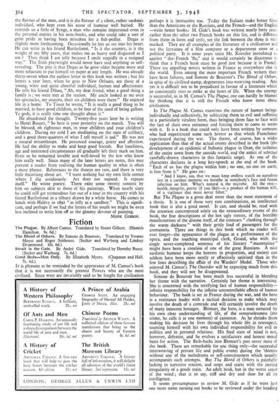Impressionist and Recluse
IN the long run only the canvas matters, but in our initial acquaint- ance with the painter his work may lose nothing by being seen against a background of personality. With the advent of Impres- sionism painting became considerably more subjective, and pictures stood to gain if viewed in their correct biographical context. Th.: artist benefits from the legend because the legend puts his public into the right mood of receptivity. Van Gogh's reputation owes much to Meier Graafe, to Irving Stone and to his own letters ; and Gauguin's diaries and correspondence have been his first introduction ' to many who were not yet ready to look at the paintings. Indeed, almost the whole group of French Impressionists are heavily in debt to their contempor4ies in literature, and when George Moore reached Elysium he was probably cold-shouldered by the authors as the complete cad, and welcomed by the painters as the apostle of light.
Degas alone can claim to have scorned the aid of any literary racket, but in this beautifully produced book we become a little bate' acquainted with this so-called recluse. Degas allowed his personality to appear, though guardedly, in his letters to his friends. One gets the flavour of the man, and it is the flavour of a silent, rather sardonic individual, who kept even his sense of humour well buried. He reminds us a little of Synge, a man who remains impersonal even in the personal entries in his note-books, and who could take a sort of grim pride in having been mistaken for a fish-pedlar. Degas is slightly more forthcoming. Occasionally he lets us see into his heart. He can write to his friend Barth°lome, "Is it the country, is it the weight of my fifty years, that makes me as heavy and disgusted as I am ? They think I am jolly because I smile stupidly in a resigned way." The Irish playwright would never have said anything so self- revealing. The pity is that Degas as he grew older became more and more reluctant to put himself on paper at any length. He was already thirty-seven when the earliest letter in this book was written ; but his letters a year later, when he goes to New Orleans, are those of a young, witty and quite cheerful individual, human and affectionate. He tells his friend Dihau, " Ah, my dear friend, what a good thing a family is ; we were met at the station. My uncle looked at me over his spectacles, my cousins, their six children were there." He enjoyed life in a home. To Tissot he wrote, "It is really a good thing to be married, to have good children to be free of the need of being gallant. Ye gods, it is really time one thought about it."
He abandoned the thought. Twenty-five years later he is writing to Henri Rouart, "So here is your posterity on the march. You will be blessed, oh righteous man, in your children and your children's children. During my cold I am meditating on the state of celibacy, and a good three-quarters of what I tell myself is sad." He was not a natural misanthrope. He possessed courage, gaiety and affection. He had the ability to make and keep good friends. But loneliness, age and straitened circumstances all gradually left their mark on him. Even so he remained lovable and well-loved by the few who knew him really well. Since many of the later letters are notes, this may prevent a reader from realising the human quality in what is often a mere phrase. References to the theatre are rare, and there is very little theorising about art. "I want nothing but my own little corner where I dig assiduously. Art does not expand. It repeats itself." He wrote poetry. There exist some twenty sonnets by him on subjects akin to those ot his paintings. When nearly sixty he could still get tremendous fun out of a tour in the country with his friend Bartholorne in a tilbury drawn by a white horse. He comes to lunch with Halevy in 1892 "as jolly as a sandboy." This is signifi- cant, and perhaps if we had the letters of his youth we might be even less inclined to write him off as the gloomy devotee of painting.
MONK GIBBON.



































 Previous page
Previous page